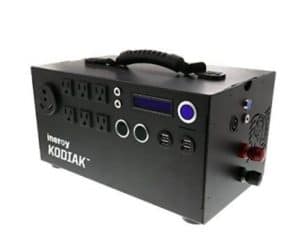A portable solar generator, increasingly significant in 2023, is your assistant in any survival situation: you don’t need a battery; solar panels are powerful enough for your purposes, the energy it produces will be sufficient. All these features make a sunlight-driven generator a great power source that can help you survive long-term. In the article, find all there is about it.
TOP Best Portable Solar Generators On Today’s Market
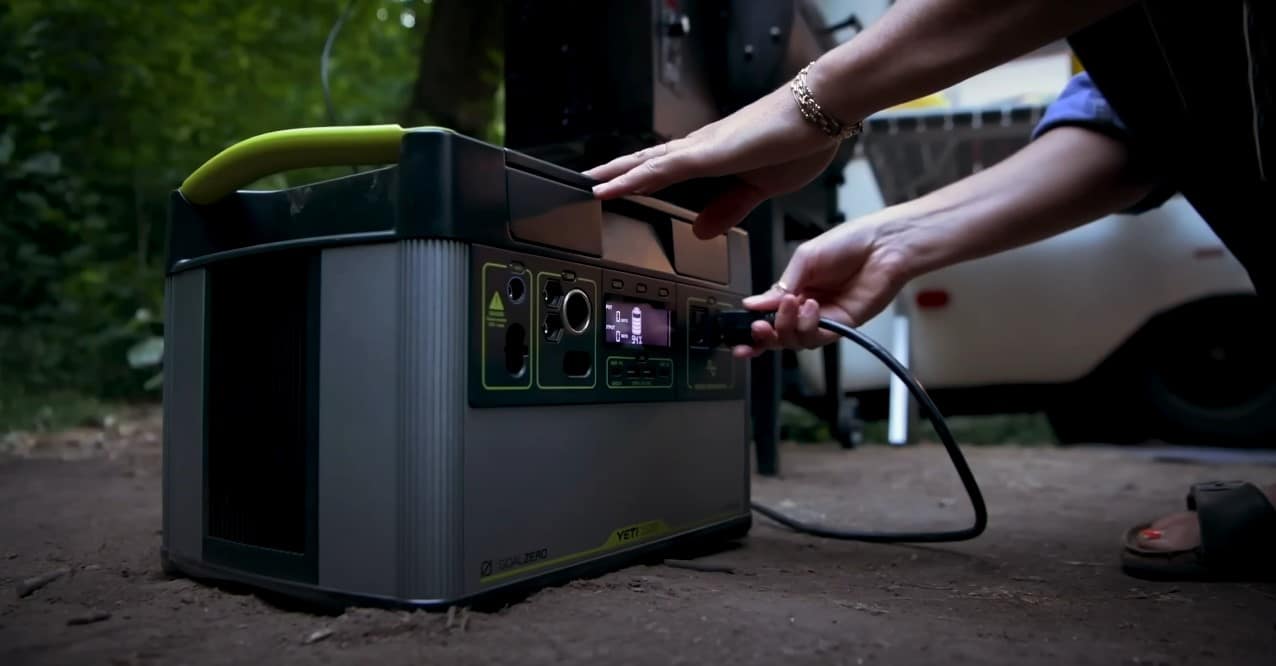
Since we have done our small research, we only present here the models satisfying basic survival needs and providing enough backup power for any emergency case.
To start with, here are some brands perfect for high-powered devices: Peppermint Energy Forty2, Jackery Power Station, Zero Point Energy— find out more searching for generator reviews on the Net.
The Goal Zero Yeti Lithium Portable Power Station
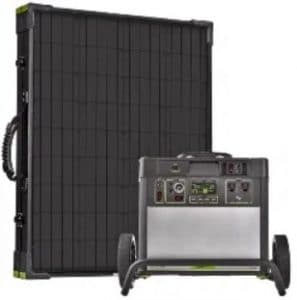
Goal Zero Yeti is a great solution if you consider buying a solid and long-lasting solar-based generator. Yet, most of these models are not supplied by a solar panel as they are sold separately.
Here is how GOAL ZERO YETI 3000 LITHIUM POWER STATION WITH WIFI + BOULDER 200 BRIEFCASE SOLAR KIT looks like.
The brand boasts several models and various sizes to choose from:
- 3000 is a 3024Wh model
- 400 is a 428Wh model.
Testing Focus: Battery Life and Output Efficiency
Test Setup: The Goal Zero Yeti was tested over a weekend camping trip. It was used to power a range of devices including LED lights, a portable cooler, and smartphones.
Results:
Battery Longevity: The Yeti powered the campsite for two full nights before needing a recharge.
Output Efficiency: It simultaneously charged multiple devices without any noticeable dip in power output.
Conclusion: The Yeti proved to be highly reliable and efficient, with a battery life that can comfortably last through a weekend of moderate to heavy use.
To briefly compare the two models, Yeti 3000 provides greater power capacity. Consequently, it costs a bigger sum of money, while the Yeti 400 aims to power smaller gadgets and perform lesser tasks but, therefore, can be called more cost-effective. It is up to you to decide which is worthier to add to your cart, but both Zero Yeti models are reliable and relatively easy to carry.
All the models comprise two 12V output ports, two AC outlets (300W continuous, 1200W surge), three 2.4A USB ports, and their weight may vary from nearly 17 lbs (for the 400 series) up to over 70 pounds (for the 3000).
- Features:
- High-capacity lithium battery.
- Multiple output ports (AC, 12V, USB) for versatile connectivity.
- Integrated informative display showing battery level and output usage.
- Solar panel compatibility for off-grid charging.
- Benefits:
- Reliable for powering multiple devices simultaneously, ideal for camping or emergency backup.
- Durable and user-friendly design.
- Eco-friendly power solution, especially when paired with solar panels.
- Potential Drawbacks:
- Higher price point compared to some competitors.
- Heavier and bulkier, which might affect portability.
- Solar panels need to be purchased separately, adding to the overall cost.
Have a look at the Yeti 3000 Solar Kit — this model comes with a solar panel — or watch the related video review.
Zero Point Energy (TITAN)
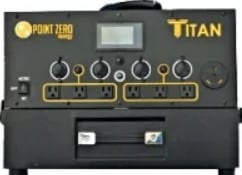
During a severe storm, a family experiences a power outage. They turn to their Zero Point Energy TITAN, which they’ve set up with multiple battery modules. It effortlessly powers their refrigerator, home Wi-Fi, and several lights, ensuring comfort and connectivity during the blackout. The family values the TITAN’s capacity and reliability, making it an essential part of their emergency preparedness kit.
Among the many solar power models, the Zero Point Titan may be called the most versatile one on today’s market. This solar-powered generator works really efficiently due to a top-quality component providing solar backup for any scenario. Using Zero Point’s intuitive technology, the Titan portable power station is not a compromise between power and size, as it is both adaptable, portable, and highly reliable.
Testing Focus: Scalability and High-Power Appliance Support
- Test Setup: The TITAN was used during a neighborhood block party to power a DJ booth, including speakers, a mixer, and lighting.
- Results:
- Scalability: Even with additional battery packs, the TITAN maintained a stable power supply throughout the event.
- High-Power Support: It successfully ran high-wattage equipment for over six hours without any issues.
- Conclusion: The TITAN’s modular design and robust power output make it ideal for high-demand situations, showcasing its versatility and reliability.
The battery is detached from the other components so that one may add or exchange batteries easily and upgrade the volumes of a personal power system.
Still not impressed enough? Then here are Titan’s primary features:
- Large efficient inverter with a no-load power draw of only 5 watts, with efficiencies 92%.
- Removable and expansible lithium-ion battery letting you add or replace batteries in the blink of an eye.
- Impressive battery capacity lasting on average 10 years.
- A mighty AC charger charging your battery pack in nearly 4 hours, with an extra-feature — you may add a second charger for an even faster charging.
- An oversized MPPT charge controller letting you include 2000 extra watts of solar power.
- Cigarette to SAE connections for easy charging from a car.
- MC4 to SAE connections for jump-starting with a solar panel.
- Features:
- Modular expandability for battery capacity.
- High inverter output suitable for running large appliances.
- Multiple charging options, including solar, AC, and car charging.
- Benefits:
- Scalable battery capacity makes it suitable for both small and large power needs.
- Powerful enough to handle high-wattage appliances, making it versatile for various situations.
- Offers flexibility in charging methods, useful in different environments.
- Potential Drawbacks:
- Initial investment can be significant, especially with additional battery packs.
- The size and weight can increase considerably with extra battery modules.
- Complexity in setup and use might be challenging for some users.
Watch the video to see how it works with your own eyes.
Inergy Kodiak 1100 Watt (1.1kWh) Power Bank Solar Generator
A solo hiker takes the Inergy Kodiak on a multi-day trek. Its lightweight and compact design make it an ideal travel companion, fitting easily into the backpack. Used for charging a GPS device, smartphone, and camera, the Kodiak supports the hiker’s navigation and photography needs throughout the journey, proving to be a dependable off-grid power source.
The Inergy Kodiak Solar Generator is a stylishly looking model very popular among survivalists’ and preppers’ gear.
Why is it so? Mainly because it’s one of the few models supporting an external battery bank connection —an option letting you include extra batteries to the Inergy Kodiak and keep greater backup power volumes for an emergency.
Testing Focus: Portability and Off-Grid Capability
- Test Setup: The Kodiak was used by a hiker over a three-day trek in a mountainous region, powering a GPS device, headlamp, and camera.
- Results:
- Portability: Its lightweight and compact design made it easy to carry without adding significant weight.
- Off-Grid Performance: The Kodiak consistently charged all devices, with sufficient power remaining at the end of each day.
- Conclusion: For outdoor enthusiasts who need a lightweight, reliable power source in remote locations, the Kodiak is an excellent choice.
Among the key characteristics of the Inergy Kodiak generators are to be mentioned:
- Its surprising weight of only 20 lbs.
- Supports adding deep-cycle lead-acid extra batteries
- Solar charging with a minimum required time of 2.5 hours
- Powerful 1100 Watt-hour lithium-ion battery lasting for 2000 cycles or more
- Features:
- Compact and lightweight design.
- Multiple ports for charging various devices.
- Lithium-ion battery technology.
- Benefits:
- Highly portable, making it ideal for outdoor activities like camping, hiking, or fishing.
- Efficient in terms of space and energy, suitable for small to medium power needs.
- User-friendly interface and easy setup.
- Potential Drawbacks:
- Lower power capacity might not be sufficient for running larger appliances for extended periods.
- Durability concerns under rough outdoor conditions.
- Limited expandability in terms of battery capacity.
It’s a great grid-down solar item worth checking out — see its capacities in action in the related video.
Still, mind that solar panels are sold separately with this model.
AIMTOM Portable Solar Generator
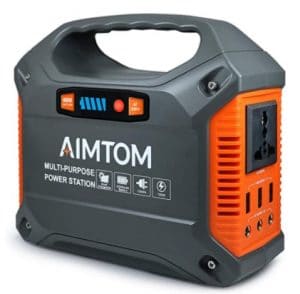
With two 110V/ 100 watt AC outlets, it is rated for 155Wh, making it a solid portable solar charger rather than a comprehensive solar generator.
Let’s list AIMTOM‘s basic features that are still very impressive for a portable solar charger:
- It has three 5V USB output for camera, phones, iPad, GPS, mp3, or even RC helicopter
and three 12V output ports (rated for max 180W, with a cigarette socket) for various car gadgets
- There are three recharging options: charge it with a car charger, a supported solar panel (sold separately), or an AC wall charger.
- The AIMTOM Generator weighs about only 3.5 lbs and comprises an easy-carry handle. Its overall design makes it a travel-friendly power companion applicable almost everywhere. You should care about buying a solar panel as it is sold separately, though.
Testing Focus: Versatility and Everyday Use
- Test Setup: The AIMTOM generator was used in a home office setting for a week, powering a laptop, desk lamp, and charging a smartphone.
- Results:
- Versatility: It adeptly handled various small to medium-sized devices, proving its adaptability in different scenarios.
- Daily Use Efficiency: The generator consistently performed well, maintaining a steady power supply with no interruptions.
- Conclusion: The AIMTOM is a versatile, user-friendly option for those needing a reliable power source for everyday electronic devices.
- Features:
- Compact size with a solid handle for easy transport.
- Variety of outputs (AC, DC, USB) for diverse device compatibility.
- Built-in Battery Management System (BMS) for safety and efficiency.
- Benefits:
- Extremely portable and convenient for travel, outdoor activities, and emergency backup.
- Versatile charging options make it suitable for a wide range of electronic devices.
- Safety features ensure device and user protection.
- Potential Drawbacks:
- Lower wattage output limits its use with high-power appliances.
- Battery life might not be adequate for prolonged usage without recharging.
- Solar panel not included, requiring additional investment for solar charging capability.
In a world of clean and renewable energy of the near future, portable solar generators cause many questions and perplexities related to their daily use. To dispel the common misperceptions and avoid any misinformation, let us deal with each key question now and sort facts from fiction.
Among the most frequent questions are the following:
- What is their principle of work?
- Are they still efficient on cloudy days?
- What happens if I lose power — will it keep me safe?
- How about a long-term or an emergency cut-off?
- How about buying a small item and upgrading it later?
- Which solar generator model is optimal?
The key issue implied in all these questions seems its reliability in terms of emergency backup energy source.
Before drawing any conclusion, let us delve deeper into the following topics:
- What A Solar Generator & How It Works
- Who and Why Should Get A Solar Generator
- Comparing Solar Generators to Fuel Generators
- Portable Solar Generator Capacity Limits
- Top Portable Solar Generators On The Market
- DIY Solar Powered Generators
- Why You Should Still Get An Electrical Plan B
What is a Solar Generator and how it Works
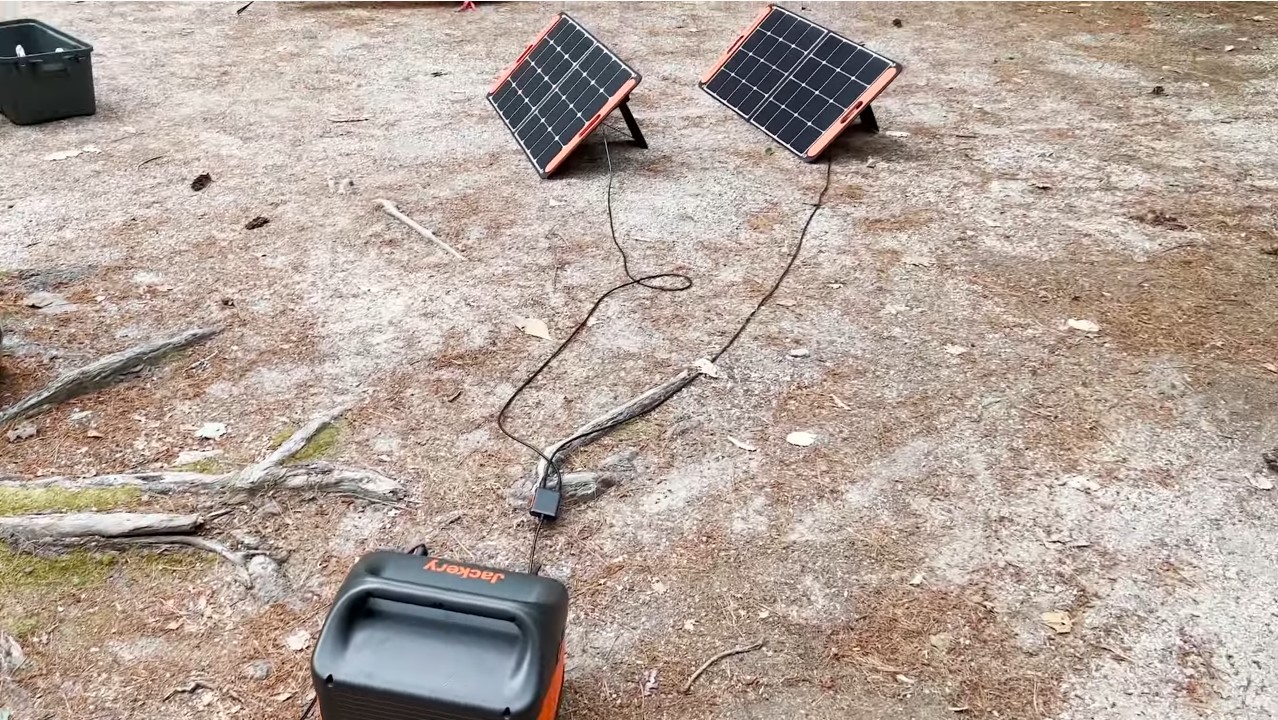
Before buying any of the wide variety of portable solar generators, it is reasonable to expand your knowledge of generators’ various sorts and how they work.
To start with the basics, a solar generator is not the same as a fuel-based generator, although both types convert raw energy into a renewable energy source. What makes them advantageous is that solar generators feed on the sun as a power source instead of some common fuels.
Let us proceed with the primary parts that make up a solar generator and its functions.
A solar generator generally comprises two main components:
- Movable power generator
- Solar panel.
1 – Solar Panels
Solar panels simulate sunlight to knock electrons free from atoms, an action producing a flow of electricity. The sun’s energy, simply put, agitates molecules, thus creating an electric current. This DC, power generation principle is almost all the technical understanding you may need.
Watch a concise TED video with Richard Komp explaining the mechanisms for converting sun rays into electricity in more detail.
2 – Portable Power Generator
A portable solar power generator consists of two main units as well:
- Battery
- Inverter
The inverter turns the DC power from the panel into more usable AC power.
Solar generators also include a storage battery. That way, if any of the power captured by the panels is not being used, you don’t lose that power.
Instead, it becomes potential energy stored in the battery for later use.
The battery ensures there’s power available in an emergency.
Solar generators also include various power outlets. These are like power outlets in your home.
They allow you to plug electrical cords, power tools, or appliances into the generator.
Comparing Solar Generators to Fuel Generators
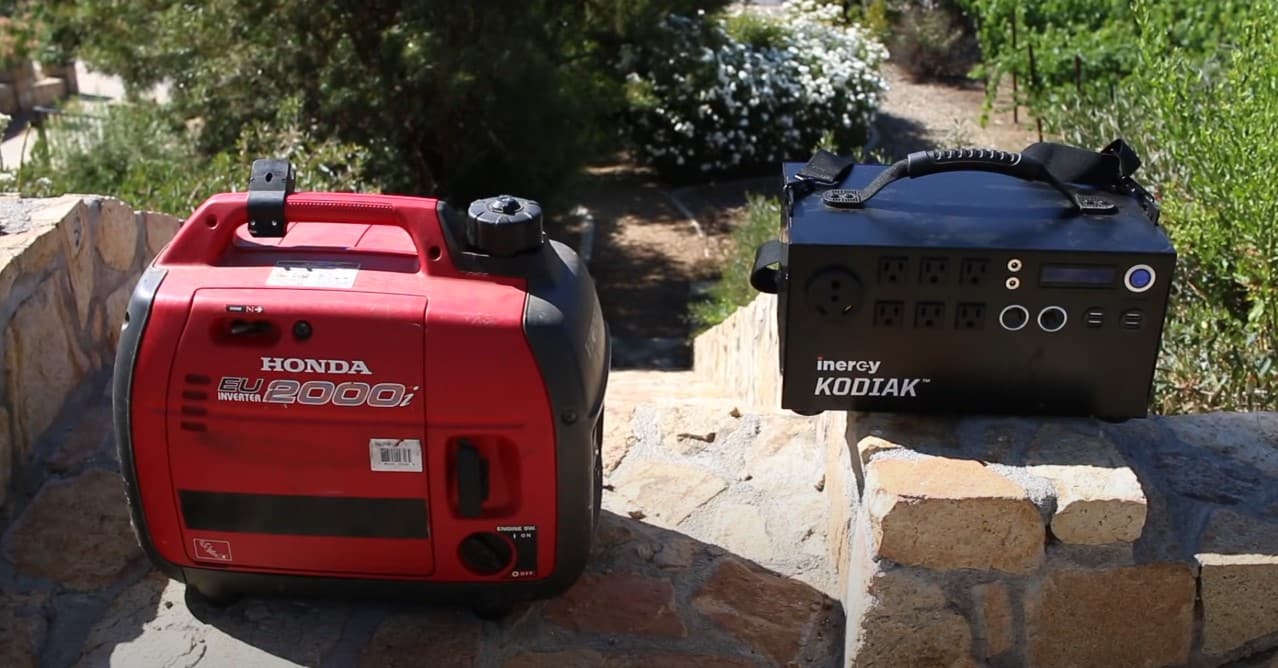
Once we have a basic notion of what a portable solar generator is and how it works, it makes sense to inquire about the reasons you might want to buy one. So, why should you invest in such a generator? Then why not lean on the old time-tested technology based on fossil fuels as a backup energy requirement?
To clarify this question, we should first consider the pros and cons of solar generators compared to fuel generators.
Fuel Is Costly
It is no secret that fuel is quite an expensive resource, and refilling our vehicles a few times per month would not enhance our savings or keep the budget.
The fuel’s price is so high due to a long chain of actions, including costly oil extraction processes and transferring to refineries, conversion into fuel, and finally — its distribution to every gas station in the area (not to mention they set their operating costs likewise).
Add those sums to the profit amount at each step and additional taxes — and here is the final price to pay at the pump.
When you are thoroughly preparing for a potential emergency, consider these costs and find cheaper analogs. If you plan to use your fuel generator during a period longer than a few days, you’ll definitely need to save and stock your sources in advance.
Consequently, choosing a fuel generator adds up to your spending, and it wouldn’t be a good idea to rely on small amounts you already have and constantly put off stockpiling for better times. Yet that’s exactly what many other people do. It is unreasonable, though, since fuel is one of the first sources to run out after a huge emergency or a long-term disaster happens. Even if you manage to find some, just pretend how enormously expensive it would be, given the laws of supply and demand.
But all these enormous fuel stockpiling spendings could be avoided if you turn your eyes to solar energy.
With solar power, your fuel is FREE.
In more detail, a good portable solar generator itself surely requires quite a sum, but the resulting amount of energy is free (so it is worth investing your money).
In fact, you get zero ongoing fuel costs by paying for a portable energy source today. Isn’t it an attractive opportunity indeed?
Fuel Can Be Dangerous and Complicated To Store And Stock
In addition to the fuel stockpiling drawbacks mentioned above, it is also complicated to store the fuel safely and for the long-run.
First of all, it is no secret that diesel is rather dangerous, liquid fuels are inflammable, and gasoline fumes are very explosive. So it is not an option to keep it close to your house or apartment.
While keeping a tiny gas can in your garage for your lawnmower is relatively safe, it is not the case with enormous barrels, as one should keep it far away from the place where he eats, sleep, and actually lives, provided that bulk fuel storage is rarely allowed in residential districts. How about keeping it outside the house? Well, exposing combustible fuels to fluctuating hot and cold temperatures is not safe at all.
Getting the special fuel rack or even building a backyard shack would require extra time and money (moreover, backyard sheds are usually not air-conditioned enough). In plus, it may be illegal for you to store a lot of fuel.
Besides, take into account the shelf life and the related fuel rotation issues, involving a fuel stabilizer, and so on — what a headache, isn’t it?
It could be easily avoided with a solar generator, though — put it in a portable garage, a pantry, a corridor, or even your bedroom…. Now the sun is doing the job for you, stockpiling your fuel day by day.
Fuel Stocks Will Run Out, Unlike Solar Power
Fuel generators are far from being called flawless due to another crucial reason: fossil fuels are not a renewable type of resource, which is not correspondent to an eco-mindset of today’s so-called progressive technologies.
But the sun’s rays from the human perspective is a ceaseless power supply. When the sun stops shining in 5 billion years, you probably won’t notice, isn’t it?
With a solar-powered energy station at your disposal, even if there is a long-term outage and no sunrays for quite a while, you are not hopeless. And with your rechargeable battery, there’s always more sun power to seize and convert, if not today, then tomorrow.
Fuel Generator Is Noisy
Yes, although fuel generators are as noisy as the neighbors’ midnight party, you can avoid usage time restrictions smoothly and easily with a solar generator, be it on the campsite or in an open field during an emergency.
And besides, in a long-term emergency outage, telling your neighbors you have a generator could be a life-risking decision (no neighbors offending intended).
Fuel Generator Creates Fumes
Along with unpleasant noise, traditional fuel and gas generators cause fumes creating lots of constant mini-explosions – this is just the way of providing huge amounts of energy (and dreadful poisonous fumes dangerous to inhale).
A just-in-case tip: never let your car warm up when the garage is closed because these fumes can kill in massive values.
Talking about truly “green” technologies, we exclude fuel generators immediately, as every schoolboy has learned about harmful fume emissions in the atmosphere when the effect does not feel that immediate, yet is not less poisonous.
Portable Solar Generator Limitations
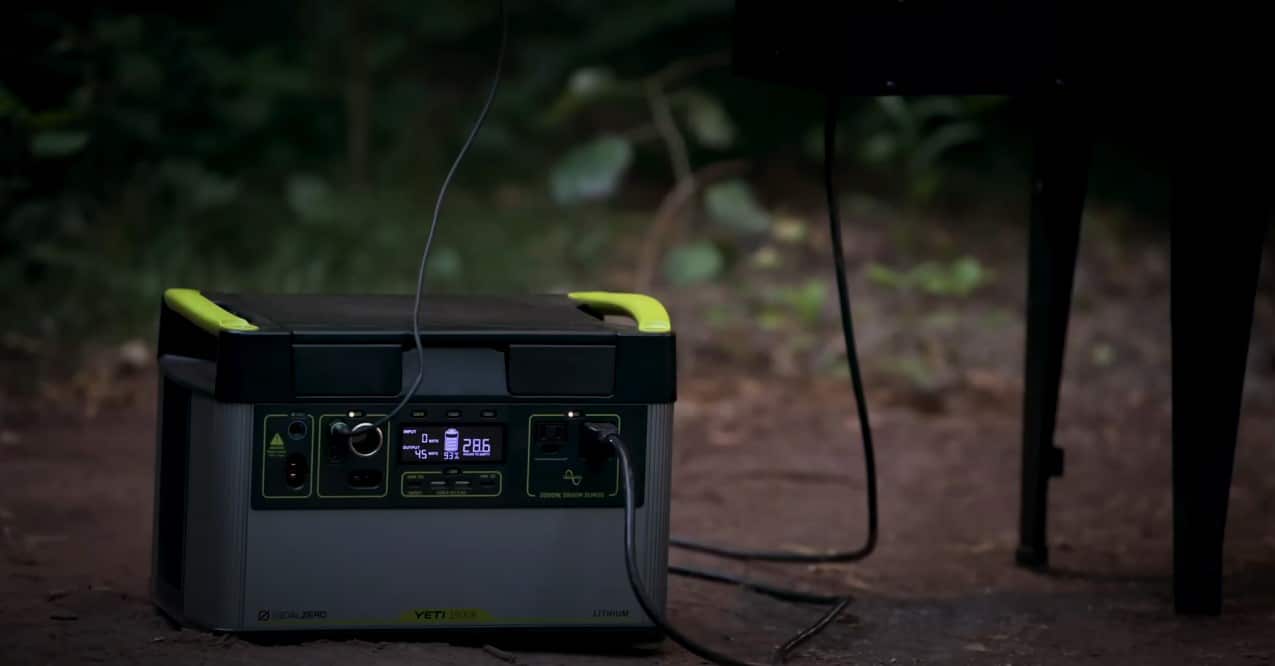
To keep you all informed, we provide you with a balanced review, including the potential drawbacks of solar-powered generators as well as the above-mentioned advantages.
So it is crucial to have a notion of what the solar generators’ limitations are in their current edition.
The Generator Output Is Eventually Limited
Do not confuse portable solar power generators with home grid power stations able to cater to the whole house or apartment.
There are certain solar array systems on a roof meeting great energy demands for the whole household, but that’s just another story, requiring specific permits and enormous budgets.
Still, portable solar generators seize a decent amount of energy.
Let’s see: on average, each American house has ALL the following appliances and gadgets:
- A Kitchen Refrigerator
- Heating and cooling network
- A TV or a few of them
- Lightbulbs and additional lights
- Deep freezer
- Laptops and Computers
- Cellphones
- C-Pap or other related stuff
- and much more.
Compare to pricy fuel generators, solar ones are less efficient, but the eventual energy is more sustainable; the upfront spendings on solar generators are more, but they are a qualitatively longer-term investment.
Solar Generator Costs More Upfront
This is true but mind the growing fuel costs as well. So, it is a kind of a vice versa logic that works here: the more you utilize your solar-powered generator, the more low-cost it gets.
In terms of fuel-generated appliances, there are usually several extra costs (literally and metaphorically) people tend to forget about:
- the cost of running out of fuel
- the disturbing noise
- fuel storage safety regulations
- harmful fumes capable of causing illnesses
- not the eco-friendly approach at all.
With the solar power station, much power comes just for free.
Recharging Is Not Instantaneous
While a lithium battery, the most common type of CPAP battery, is recharged by Solar Panel/Wall Outlet/Car within a few hours, it takes more time for a solar panel to recharge, as you might see.
For instance, you live in Alaska and are concerned whether the sun energy amounts are enough for the generator to last — well, in fact, solar panels are affected by the angle of the sun to their surface (LCD screen), so it depends on a specific fixed position of its LCD display. It starts gradually, ramping up to the peak point, holds peak power conversion for a certain while, and then decreases back down to zero.
The smart maintenance principle will help here: make sure you can produce enough power over the dark time to run your devices and appliances and charge by solar your battery and then utilize the stored backup battery power from sundown to sun up.
Battery expansion is surely a costly process, involving extra panels and bothering about excess energy — all this requires advanced energy management skills.
Many Generator Units Cannot Be Easily Expanded.
The inverter components in the ready-made solar generator products are not usually easy to expand and upgrade. One can’t simply buy an internal bigger battery or upgrade the photovoltaic surface area.
Certain models do let you buy extra solar panels to speed up your recharging process.
Still, in most cases, you get what you get with a ready-made solar-powered station.
Generator Repair Can Be Difficult
Solar panels and power generators are not repaired in two simple steps, requiring professional expertise help. It is not going to be as easy as changing a car tire.
There are still some doubts regarding their emergency durability, as well: not every model can last through a violent hail storm. However, it may provide your family with sufficient energy to last during the long cut-off.
Who Should Get A Solar Generator
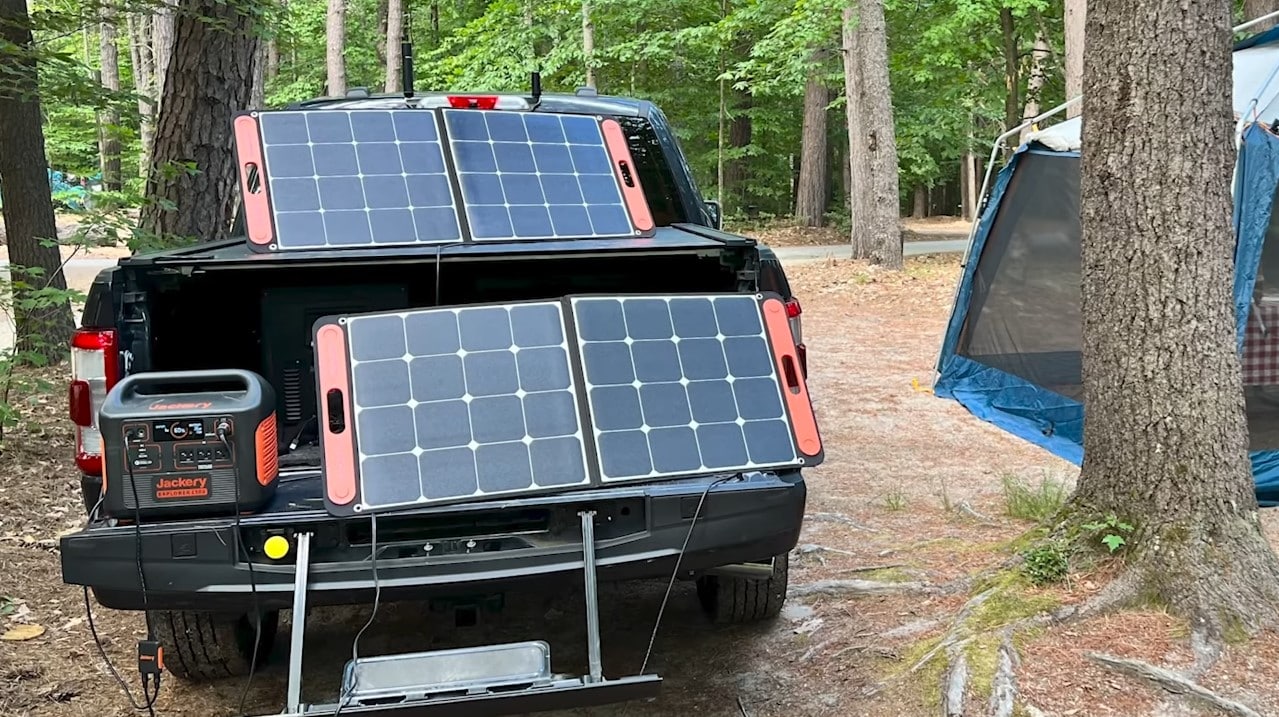
So now that you have the basic notion of solar generators’ capacities, key features, and limitations, it is reasonable to find out if they suit YOU personally.
Ask yourself, what are your actual situation and your survival strategy? And we will ask you more related questions and at the same time give you some basic guidelines regarding the pros and cons of the purchase.
Are you planning to prepare an energy backup plan for an emergency (not a 100% power replacement for all house)? If yes, it is worth buying a portable solar device.
Key Prioritization Questions To Ask:
Do you want one to launch a small backup refrigerator in an emergency? Good, a solar-powered generator can do so, but it is almost all one item capable of covering.
Do you plan to run a CPAP machine and also charge a few smartphones? Mind that, in this case, running a freezer at a time e is less possible.
Do you plan to leave the lights at night and be able to utilize your microwave four times a day? Great, this is an option then.
A holistic approach in terms of power and wise prioritization is your option if you think of buying a portable solar-based device. However, due to a reliable battery management system, it is usually safe enough even for a child to use it.
Let’s deal with an example: the best solar generators are rated for 1,500 watts of power or even more. That is enough to maintain the following appliances:
- cell phone
- tablet
- a small survival radio or ham radio (or a CB Radio — check out the difference first)
- several lights
- some necessary medical device.
Obviously, this depends on the real amount of energy required by overall device models when working together.
Otherwise, you may go without a laptop but have permanent access to your freezer, and thus, food stockpiles are going bad.
But the matter is that once you want to ensure you get it all covered, you will surely have to invest your money in more than one generator.
Another reasonable strategy is investing in self-reliant solar lighting all around the house since solar lanterns have solar panels inbuilt in their design and apply LED technology.
Here’s a solar lanterns review to give you more details before you make a purchase.
So the bottom line is this:
To make it an investment of your money and not a waste of budget, you should carefully sort out all the capacities and incapabilities of the devices we discuss today.
Already made your decision? Then let’s proceed to our hand-curated top solar-based models list.
DIY Solar Powered Generator
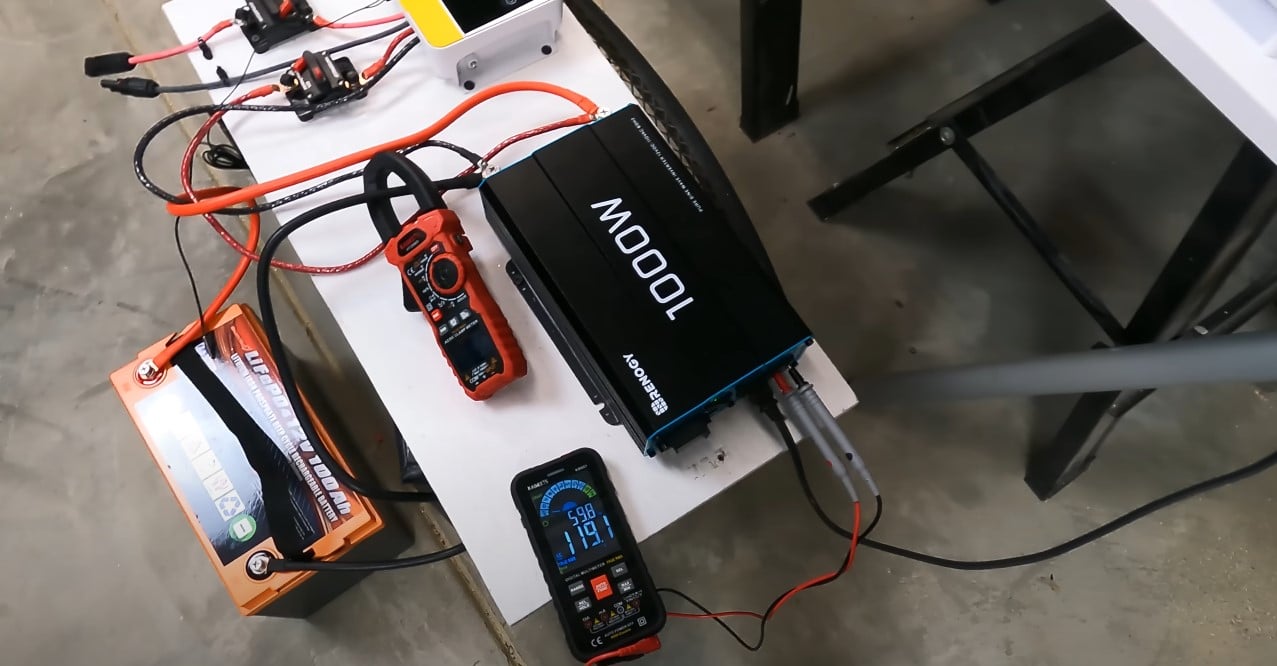
There are helpful blueprints on how to build a DIY solar generator system on the Internet, so you may steadily follow a step-to-step guide and avoid greater spendings.
We also recommend you to check out these Smart Solar Box DIY Solar Generator plans.
Why You Should Still Have An Electrical Plan B

A similar idea sounds in one of the great and well-known quotes:
“What we call survival today is what our great-great-grandparents called everyday life.”
Isn’t it mostly true? Here are only several inventions and technologies, making us less self-reliant (and thus, more prepared for unexpected scenarios):
- The Electricity And Power Grid
- Grocery Stores and overall Food Distribution System
- Corporate Farming
- Food Manufacturing
- Interstate Delivery
- Refrigeration Technology
- The Water Distribution System
- and so on.
Take one of these advancements away, and what will happen? Unfortunately, only a few people have a working plan B and therefore may survive without help and instructions.
The controversy is that modern conveniences come at the cost of human self-reliance. Therefore, we depend more and more on gadgets — in troubling times, can you evaluate these technologies’ real costs? In a long-term emergency blackout, how would you survive several months without power?
Still, among the technologies increasing our self-reliance are those solar generators and portable power stations we talked about today, which are worth investing money in before emergency outbreaks.
Best Solar Generator Summary
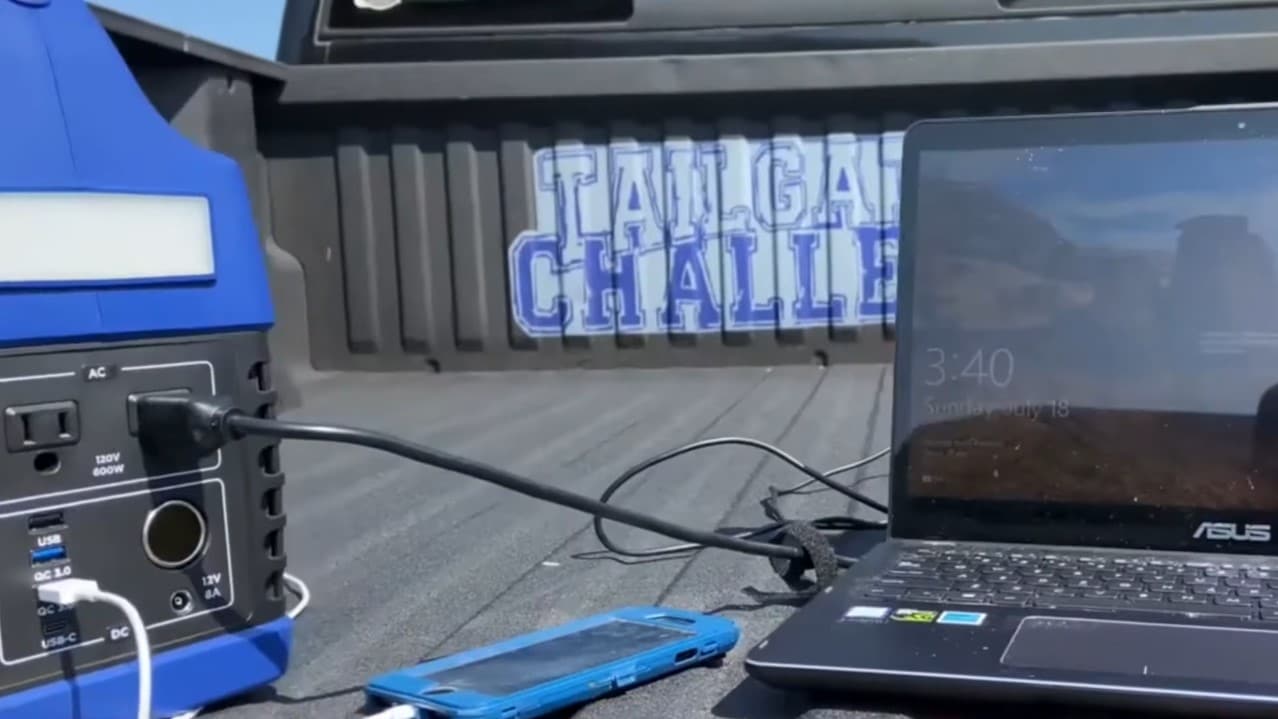
To sum it up, the sun is a long-lasting power source, and solar-powered generators definitely deserve a place in the overall survival strategy.
Frequently Asked Questions – FAQ
Can a solar generator power a house?
The matter is that a single solar generator cannot provide it all, yet its power output is enough to charge the freezer and some small gadgets (a cellphone, a laptop, and so on). Find out more in our article, mainly in the “Portable Solar Generator Limitations” chapter.
Are solar-powered generators any good?
Sure, they are suitable for RV, very good for backup campsite power during a long outage or an emergency as solar power is a renewable and easy-to-access continuous power source.
What size solar portable generator do I need to run a refrigerator?
With a solar panel producing 1,000 Wh per day, you will generally have to acquire one or two solar panels to run a middle-sized fridge. With a 2, 000 watts, 2, 500 watts or more power output, you can surely run even a bigger one.

